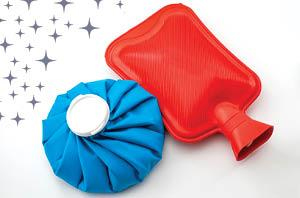When to Apply Heat or Cold for Pain Relief and Healing
Dealing with pain and injuries is an inevitable part of life, but thankfully, we have two powerful contenders in our corner: heat and cold therapy. The former, also known as a hot or warm compress, is primarily employed to soothe muscle spasms and promote relaxation. Meanwhile, the latter, commonly known as RICE (Rest, Ice, Compression, Elevation), is a go-to for reducing inflammation and numbing acute injuries.
These simple yet effective home remedies, often referred to as the dynamic duo of pain relief, have been used for generations to alleviate discomfort and accelerate healing. But how do you know which one to turn to when your body is in distress?
In this blog, we’ll delve into the age-old debate of heat versus cold therapy, arming you with the knowledge to make the right choice for your specific aches and pains.
Cold Therapy (Cryotherapy):
Use cold therapy for acute injuries or conditions, where there is inflammation, swelling, or recent trauma. Applying cold to the affected area helps constrict blood vessels, reduce blood flow, and decrease inflammation, which can help alleviate pain and prevent further swelling. Cold packs or ice packs are commonly used for this purpose.
When to use cold therapy:
- Acute injuries (e.g., sprains, strains, bruises)
- Swelling and inflammation
- Tendonitis
- After intense physical activity to reduce muscle soreness
Heat Therapy (Thermotherapy):
Heat therapy is beneficial for chronic conditions or injuries where there is tightness, stiffness, or muscle tension. Applying heat helps dilate blood vessels, increase blood flow, and relax muscles, which can relieve pain and improve flexibility. Heat can be applied using warm towels, heating pads, or warm baths.
When to use heat therapy:
- Chronic muscle pain or tension
- Stiff joints
- Muscle spasms
- Ongoing joint pain (not associated with inflammation)
Some Important Considerations
Here are some things you should take note of when choosing which treatment you should utilize:
- Avoid using heat on acute injuries or areas with swelling, as it can increase blood flow and potentially worsen inflammation.
- Do not use cold therapy for prolonged periods, as it can lead to tissue damage or frostbite.
- Always use a barrier (such as a cloth or towel) between the heat/cold source and your skin to prevent burns or frostbite.
- If you have circulatory issues or nerve damage, consult a healthcare professional before using heat or cold therapy.

